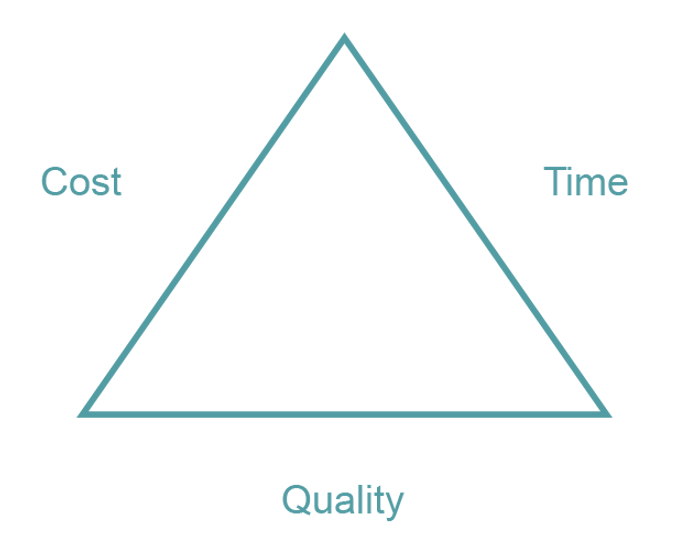The ‘Iron Triangle’ in Construction

I was talking to one of my oldest friends recently, a guy who had been in the construction industry the same length of time as me even though he is a couple of months older. During our discussion, I mentioned that to become the best project manager in the industry you only have to manage three things which form the “Iron Triangle”. The old bloke was mesmerised as he had never heard of it. A few weeks later he called and told me he had been thinking about the “Iron Triangle” and couldn’t find an exception so I thought I would mention it as the principle may not have crossed the mind of some people.
The ‘Iron Triangle’

In the construction industry, there are three “cornerstones” i.e. Time, Cost, and Quality which apply to every project. At least one of these “cornerstones” will be at the fore in every project, sometimes two share the lead.
We all know the saying “every dollar counts” and we all know that the first question most clients ask is “how much will it cost?” but cost isn’t always the most important factor. Cost also relies on other factors.
The Iron Triangle in context
A good example is an aged care project I worked on a few years ago. They had a great Quantity Surveyor on the project (it was me) and so they had no problems with the budget. The quality was predetermined as they had other facilities and knew what worked as far as maintenance, replacement, wear and tear. They had a very good idea of the quality required and had completed a few life cycle cost exercises. However, they had a problem in that they had purchased bed licenses for the new facility but because the local council had surprisingly taken a lot longer to issue a DA the time was running out on the licenses. I’m not sure of the exact cost of forfeiting eighty or so bed licenses for an aged care facility but it had their upper management in a twist. The CEO who I had never seen even remotely flustered was not himself.
As it turned out the project didn’t have to be completed to hold the licenses, it had to reach a certain stage, something like a substantial start to hold a DA or a demonstration of commitment. The project went to tender and In this case, “time” would be the essential factor. The lowest tender would not necessarily be selected. The selection would be based on the tenderer that could persuade a panel that they could reasonably attain the required level of completion by the set time.
After much questioning and calculation, a successful tenderer was chosen, not the lowest but the one who could meet the time constraint. In this example cost wasn’t the determining factor but the time constraint did impact the cost. To satisfy the time constraint certain activities were “accelerated” and certain provisions were necessary “out of sequence”. There are two words that anyone experienced in contractual claims in the construction industry will understand, they mean costs.
Just to end the story, the successful tenderer achieved the critical date and made it look easy, which would have been difficult, and demonstrates their expertise. They turned out to be one of the best builders I had come across in my whole working life, what a shame I didn’t meet them years before when all I seemed to do was deal with scoundrels in dispute situations.
How the Iron Triangle works
The principle behind the “iron triangle” is that time, cost, and quality are related i.e. if you change the time you affect the cost and the quality, if you change the cost you affect the quality and the time and if you change the quality you affect the cost and the time.
For example let’s just look at one small impact if time is adjusted:
Increase the time = duration for the project preliminaries increases affecting cost
Increase in time can affect quality
Decrease the time = duration for the project preliminaries decreases affecting cost
decrease in time can affect quality e.g. a “rush job”
The impact is similar if you increase or decrease the cost and quality. The following gives a graphic representation of the relationships:

Time, cost and quality interact and have an impact on each other.



